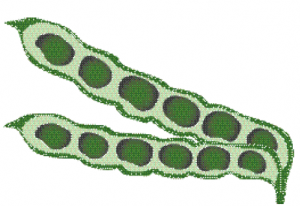Favorite Favas
 Perhaps the least known legume in North America, fava beans have served as a culinary staple dating back to prehistoric times. The versatile fava bean, a member of the pea family, answers to other names, including broad, horse, English, or Windsor Bean. Harvested in the spring, fava beans hold up to refrigeration for several days, and store well when either frozen or dried. Fava beans are often a sign of spring in Europe and in restaurants across the U.S. What a great way to add beautiful colors to your meals!
Perhaps the least known legume in North America, fava beans have served as a culinary staple dating back to prehistoric times. The versatile fava bean, a member of the pea family, answers to other names, including broad, horse, English, or Windsor Bean. Harvested in the spring, fava beans hold up to refrigeration for several days, and store well when either frozen or dried. Fava beans are often a sign of spring in Europe and in restaurants across the U.S. What a great way to add beautiful colors to your meals!
Nutritional Benefits of Fava Beans
Like other legumes, fava beans provide a generous amount of both soluble and insoluble fibers and phytochemicals. Soluble fiber helps lower LDL cholesterol, while insoluble fiber acts as a broom in your large intestine. The phytochemicals in fava beans may also inhibit the growth of certain cancers.A single cup of cooked fava beans provides 187 calories, 13 grams of protein, virtually no fat, 60 mg of calcium, 4 mcg of selenium, 175 mcg of folate, and 9 grams of fiber.
Cook with Fava Beans
While the mature beans cook in a similar way to lima beans, fava beans provide a less starchy mouthfeel, which is a big plus for many diners. Like other beans, fava beans are mild in flavor and adaptable to many culinary applications.
- Use fava beans in soups, pasta dishes, and casseroles.
- Try them in a stir-fry.
- Saute fava beans with olive oil, add lemon juice or flavored vinegar, and include seasonings like garlic, basil, oregano, and black pepper. Serve the sauteed beans as a side dish, or cool them and serve everything as a salad.
- Add rosemary and garlic to cooked fava beans and top with Parmesan cheese.
- Make a springtime vegetable medley using favas, broccoli, artichokes, carrots, and/or mushrooms.
- Include fava beans in risotto or your favorite rice dish.
- Try tossing them with traditional salad fare (lettuces, spinach, tomatoes, mushrooms, etc) or toss them alone with grated carrot and minced bell peppers.
- The sauteed beans can also be pureed with a little olive oil, vinegar and fresh herbs such as parsley, rosemary and garlic. Serve the puree as a sauce for grilled fish or poultry, or as a dip for crusty bread or vegetables.
- Include fava beans in a variety of dishes and impress family, friends, and clients with your culinary knowledge!
Fava Bean Success Tips
Still not sure about fava beans? Sometimes a little know-how is all you need to make a new vegetable less intimidating. Check out the fava success tips that we've outlined below...
- Early in the season, when the fava bean is young and fresh, you can eat the bean and pod together. You know, like snap peas.
- Mature but still young beans are best once they are removed from the pod. However, they are tender enough to eat in the skin, even raw.
- Older and larger beans require parboiling to loosen the skin. (The skin becomes tough with age). If the process doesn’t completely remove the skin, manually slip the bean from the skin before serving.
- Make the shelling and peeling of fava beans a social activity. Guests often congregate in the kitchen and would probably love to see how you prepared these unusual beans.
A Word of Caution
Individuals on medication to increase dopamine levels (as in Parkinson’s disease) or to block dopamine catabolism (MAO inhibitors) should consume fava beans with caution or not at all. Also, individuals native to the Mediterranean countries and parts of Asia may experience a genetic sensitivity to catabolic products of fava beans. This condition is called favism. Initial symptoms mirror flu and are easily treatable, but if not treated favism develops into hemolytic anemia. Talk with your doctor if you have any concerns about fava beans.By Rachel Trevethan, MS, RD, LD.